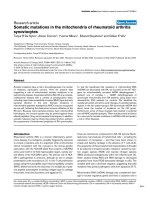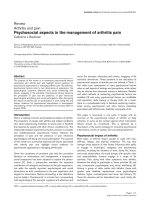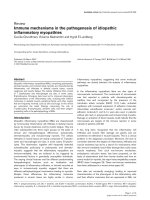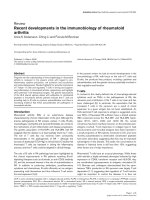Báo cáo y học: "Another piece in the puzzle" pot
Bạn đang xem bản rút gọn của tài liệu. Xem và tải ngay bản đầy đủ của tài liệu tại đây (29.03 KB, 2 trang )
27
IR = ischemia–reperfusion.
Available online />The multifaceted phenomenon of pulmonary
ischemia–reperfusion (IR) involves alveolar macrophages,
vascular endothelial cells, circulating neutrophils, adhesion
factors, free radicals, and a wealth of cytokines. There is a
large body of literature describing techniques to attenuate
lung IR injury. To date, however, little attention has been
focused on the specific mechanisms of lung IR injury itself.
The complexity and amplification of the cascades involved in
this phenomenon have made investigation of individual
components of reperfusion injury difficult to assess.
Characterization of the injury pattern during the early phase
of reperfusion is limited. Van Putte and colleagues [1] have
attempted to provide insight into and describe some of the
key components of this process using a warm blood
perfused model. Fiser and coworkers [2] recently described
the biphasic nature of reperfusion injury after lung
transplantation, beginning with a resident (donor)
macrophage response followed by a more intense response
of circulating (recipient) neutrophils. Evidence that
neutrophils play an important role in lung reperfusion injury
has been reported by investigators using leukocyte depletion
techniques as well as antibodies directed at adhesion
molecules [3,4]. In contrast, some investigators have
demonstrated that significant IR injury can occur without
neutrophil participation, and in fact neutrophils may have no
effect at all in some models of lung injury [5]. Our group [6]
recently utilized a model that eliminates the role of circulating
neutrophils altogether and allowed us to focus strictly on
resident macrophages in the lung.
Despite the controversy surrounding the exact role played by
circulating neutrophils, they are a critical component of the
inflammatory cascade. The study by Van Putte and
colleagues [1] clearly demonstrates a specific bimodal, time-
dependent course for neutrophil infiltration (30 mins and
3 hours) after reperfusion. This new finding suggests that
there is not only a recruitment phase of neutrophils but also a
time-dependent activation phase.
The identification of apoptosis within pulmonary IR injury is
perhaps one of the more significant findings in the
experiment [1]. Although this particular study did not
investigate the cell signaling mechanisms that are involved in
programmed cell death, future studies will certainly better
define this mechanism.
Van Putte and coworkers [1] successfully utilized a warm
pulmonary IR model to investigate very specific components
of a complex physiologic process. Their study verifies some
Commentary
Another piece in the puzzle
Thomas S Maxey
1
and William B Keeling
2
1
Chief Resident, General Surgery, Department of Surgery, University of South Florida College of Medicine, Tampa, Florida, USA
2
Senior Resident, General Surgery, Department of Surgery, University of South Florida College of Medicine, Tampa, Florida, USA
Corresponding author: Thomas S Maxey,
Published online: 9 December 2004 Critical Care 2005, 9:27-28 (DOI 10.1186/cc3019)
This article is online at />© 2004 BioMed Central Ltd
See Research by Van Putte et al., page 119
Abstract
Pulmonary ischemia–reperfusion injury is complex and involves many cell types and mechanisms of
action. Van Putte and coworkers have attempted to provide insight into and describe some of the
complex components of this process. Their study describes two new components of the multifaceted
process of reperfusion injury. The time-dependent course of neutrophil activation and the discovery of
programmed cell death in reperfused lung tissue are two new pieces of a complex puzzle.
Keywords ischemia–reperfusion injury, lung injury, pulmonary
28
Critical Care February 2005 Vol 9 No 1 Maxey and Keeling
previously described mechanisms of pulmonary IR injury and
sheds new light on other mechanisms. Although these
findings may not have immediate clinical implications, they
certainly add another piece to a complex puzzle.
Competing interests
The author(s) declare that they have no competing interests.
References
1. Van Putte, Kesecioglu J, Hendricks JMH, Persy VP, Van Marck E,
Van Schil PEY, Debroe ME: Cellular infiltrates and injury evalu-
ation in a rat model of warm pulmonary ischemia-reperfusion.
Crit Care 2005, 9:R1-R8.
2. Fiser SM, Tribble CG, Long SM, Kaza AK, Cope JT, Laubach VE,
Kern JA, Kron IL: Lung transplant reperfusion injury involves
pulmonary macrophages and circulating leukocytes in a
biphasic response. J Thorac Cardiovasc Surg 2001, 121:1069-
1075.
3. Breda MA, Hall TS, Stuart RS, Baumgartner WA, Borkon AM,
Brawn JD, Hutchins GM, Reitz BA: Twenty-four hour lung
preservation by hypothermia and leukocyte depletion. J Heart
Transplant 1985, 4:325-329.
4. Ferro TJ, Gertzberg N, Selden L, Neumann P, Johnson A:
Endothelial barrier dysfunction and p42 oxidation induced by
TNF-
αα
are mediated by nitric oxide. Am J Physiol 1997, 272:
L979-L988.
5. Steimle CN, Guynn TP, Morganroth ML, Bolling SF, Carr K, Deeb
GM: Neutrophils are not necessary for ischemia reperfusion
injury of the lung. Ann Thorac Surg 1992, 53:64-73.
6. Maxey TS, Enlow RI, Gaston B, Kron IL, Laubach VE, Doctor A:
Tumor necrosis factor-alpha from resident lung cells is a key
initiating factor in pulmonary ischemia-reperfusion injury.
J Thorac Cardiovasc Surg 2004, 127:541-547.









